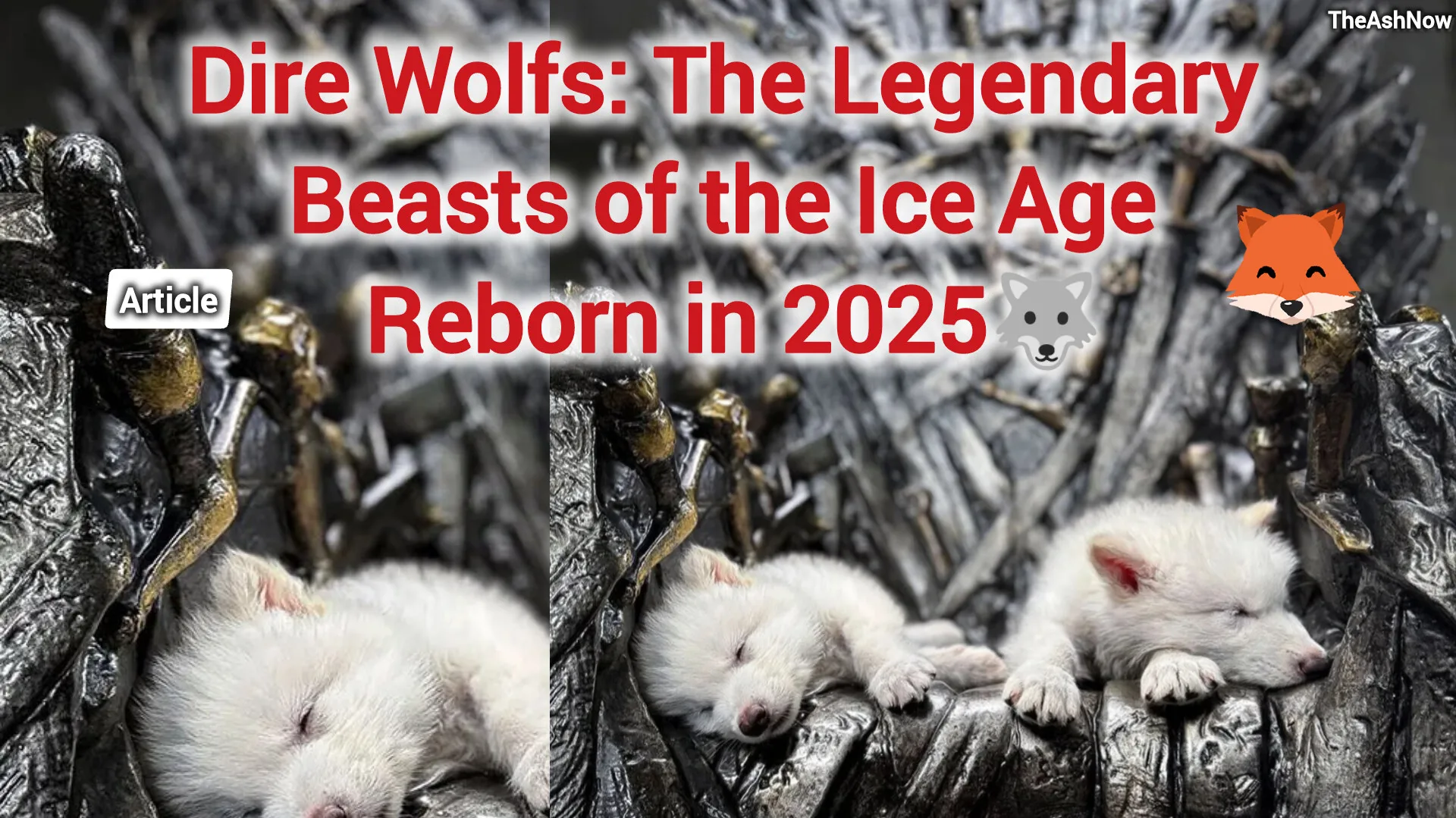Once feared and revered across Ice Age North America, the Dire Wolf—or as we’re calling it, the “Dire Wolfs”—has returned from the pages of paleontology into the headlines of 2025. From myths and fossils to DNA resurrection and cloning labs, these ancient predators are now the talk of modern science and global pop culture.
Thanks to ambitious biotech companies like Colossal Biosciences, the boundary between extinct and alive has blurred like never before. But how much do we know about Dire Wolves? How are they different from today’s gray wolves? Can science truly bring them back—or are we chasing a Jurassic fantasy?
Let’s break it all down.
1. What Exactly Is a Dire Wolf?
The Dire Wolf (Aenocyon dirus) was a species of canine that lived during the Late Pleistocene epoch, roughly 125,000 to 9,500 years ago. Often confused with the modern gray wolf, it was larger, stockier, and had a more robust build, adapted to hunting large Ice Age mammals.
- Scientific Name: Aenocyon dirus (meaning “terrible wolf”)
- Weight: 150–175 pounds
- Range: Across North and South America
- Extinction: Around 9,500 years ago
Unlike today’s wolves, Dire Wolfs were not ancestors of modern canines but evolved on a separate lineage, making them genetically very different.
2. What Made Dire Wolf So Unique?
Dire Wolves weren’t just oversized wolves—they were apex predators with physical and behavioral adaptations suited to the Ice Age world.
Key Differences from Gray Wolves:
| Feature | Dire Wolf | Gray Wolf |
|---|---|---|
| Build | Bulkier, stronger jaws | Leaner, more agile |
| Teeth | Massive crushing molars | Sharper for slicing |
| Genetics | Different genus (Aenocyon) | Canis lupus |
| Diet | Megafauna (bison, horses) | Deer, elk, small mammals |
Their strong bite could crush bone, helping them consume more of a carcass. However, this specialization may have contributed to their extinction when large prey vanished.

3. Fossil Finds & the La Brea Tar Pits
The La Brea Tar Pits in Los Angeles have yielded thousands of Dire Wolf fossils, making it one of the best-documented prehistoric species. Over 4,000 individual skeletons have been discovered there alone.
This incredible fossil record gave scientists rare insight into:
- Pack behavior and population dynamics
- Sexual dimorphism
- Disease and injuries among individuals
- Their disappearance after climate shifts post-Ice Age
4. Enter Colossal Biosciences: The De-Extinction Project
In 2025, Colossal Biosciences, known for its efforts to revive the woolly mammoth, announced it had successfully created viable Dire Wolf embryos. Their aim? De-extinction through advanced genetic engineering and cloning.
🧬 Key Technologies Involved:
- CRISPR gene editing
- Synthetic genome reconstruction
- Somatic cell nuclear transfer
- Surrogate implantation in modern wolves or dogs
While the embryos are not 100% “pure” Dire Wolf, they contain a high percentage of Aenocyon dirus DNA.
According to Colossal, their revived Dire Wolf is being nurtured in high-security biolabs and is expected to be born by late 2025 or early 2026.
5. Public Reactions: Jurassic Excitement or Ethical Concern?
The internet exploded when the news broke. Headlines like:
- “Dire Wolf Returns After 12,500 Years!” (TOI)
- “Jurassic World Reacts With Ironic Warning” (HT)
- “Science Fiction Meets Reality” (The Cut)
Social media is awash with fan theories, memes, and comparisons to Game of Thrones’ dire wolf companions, further blurring the line between fantasy and reality.
But scientists and ethicists have raised serious questions:
- What ecosystem will they live in?
- Will they be dangerous to humans or animals?
- Is it ethical to create a being with no natural habitat or social structure?
6. Dire Wolfs in Pop Culture: From Thrones to TikTok
Dire Wolf have had a massive cultural resurgence, especially due to their iconic presence in HBO’s Game of Thrones. The direwolves of House Stark became symbolic of loyalty, protection, and wild power.
In 2025:
- TikTok is flooded with edits and theories
- YouTube creators are debating if they should exist
- Reddit threads on r/Pleistocene and r/Science are tracking every new lab leak
Suddenly, paleontology is trending again.
7. Are They Really Dire Wolfs… or Just Designer Dogs?
Here’s the catch: the “Dire Wolf” being born in labs are not clones in the pure sense. Their DNA is reconstructed using:
- Fossil samples
- Modern canine surrogates (dogs, wolves)
- Artificial DNA synthesis
Experts suggest they’ll be “chimeras” — genetically close to Dire Wolf, but possibly with differences in behavior, size, or appearance. Think of them as neo-Dire-Wolf, not perfect replicas.
Colossal claims this is “de-extinction 2.0” — not just revival but reinvention.
8. Ethical Dilemmas & Scientific Risk
Reviving extinct species isn’t all glory and discovery. The field of de-extinction faces serious concerns:
- Ecological Disruption: What happens when you reintroduce a top predator into a world that moved on without it?
- Animal Welfare: Is it fair to raise ancient creatures in modern labs with no wild environment?
- Genetic Stability: CRISPR errors and unforeseen mutations could make these creatures unstable.
- Legal Gaps: There are no global laws regulating lab-created extinct species.
Critics argue that the billions spent on this project might be better used to protect endangered species already alive.
9. The Future of De-Extinction: From Fantasy to Frontier
The Dire Wolf is just the beginning.
Colossal and similar biotech firms are already exploring the revival of:
- Woolly Mammoths
- Dodos
- Tasmanian Tigers
- Cave Lions
If successful, we may soon live in a world with mixed timelines — modern humans coexisting with species from the Ice Age.
Some see this as scientific redemption. Others, a dangerous game of god.
Conclusion: Should We Be Excited or Afraid?
The dire wolf’s return is more than a scientific miracle. It’s a mirror reflecting our deepest hopes and fears about power, control, nature, and history.
Are we ready for the creatures we lost—or the ones we’re creating in their image?
Whether you’re thrilled or terrified, one thing is clear:
Dire Wolf are no longer a thing of the past.
They’re a living part of our future.
🔗Research Sources: Wikipedia, TIME, CNN, CBS, Reddit, The Cut, USA Today, Al Jazeera, Indian Express, TOI, Hindustan Times, BBC
Read More:👇









2 thoughts on “Dire Wolfs: The Legendary Beasts of the Ice Age Reborn in 2025🐺”